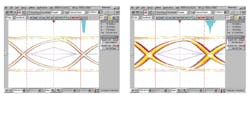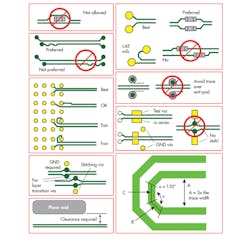Download this article in .PDF format
This file type includes high resolution graphics and schematics. |
The race to embrace new high-speed interfaces like USB 3.0, DisplayPort 1.2, and PCI Express 3.0 has created tremendous stress for electronics OEMs around the world. The increase in data rates introduces challenging signal integrity issues of a magnitude that digital designers have never had to face before.
It’s not that these new interfaces are impossible to implement. Rather, engineers have much less error margin to work with. Attenuation, jitter, and impedance become even more important to handle carefully. If these factors are too pronounced, interface reliability suffers in ways that can directly impact the user experience through digital media quality degradation, substantially reduced throughput, and even loss of data.
Attenuation
The farther and faster a signal has to travel through a system, the more it will degrade. For example, the attenuation losses of an interface operating at 2.5 Gbits/s are commonly on the order of 0.3 dB per inch of FR4 printed-circuit board (PCB) trace. Moving to a next-generation interface operating at 8 Gbits/s brings attenuation up to 0.9 dB, nearly tripling the losses.
Related Articles
As a consequence, high-speed interface standards typically require the receiver and transmitter to be placed right next to the interface connector to minimize trace length. With the many interfaces today’s complex systems need to support, however, physically accommodating this requirement isn’t always possible.
Consider an average notebook with high-speed video connectors (HDMI or Display Port), a high-speed USB 3.0 connector, PCI Express slots, and possibly a Thunderbolt connector. To fit all of the I/O connectors on a single platform, a designer isn’t going to be able to easily lay out each high-speed transmitter next to its paired connector. Certain transmitters then will need to drive multiple inches of trace with possible vias until the signal finally reaches its paired connector. The same issue arises with highly integrated processors supporting multiple interfaces whose pinouts may not match the placement of the physical interface connectors on the board.
Jitter
Several forms of jitter impact signal integrity. Deterministic jitter arises from differing transition rates within the data signal. As high-speed interfaces have more variation along the data stream, engineers must deal with greater jitter. A primary source of random jitter is a noisy source clock. The host processor or an external clock source generates this clock, and it runs concurrently with the data signal.
Ideally, the clock signal is as accurate as possible, and many technologies can provide the required accuracy. However, the chip sourcing the clock may be difficult to place next to the interface transceiver. For example, when the host processor sources the clock, the interface transceiver must compete with all of the other subsystems to be near the host while still being close to the interface connector. When the clock signal has to run long distances, more noise can couple onto the signal and introduce random jitter unless there is good isolation, along the clock path. In addition, if impedance mismatching occurs, clock signal quality degrades even faster.
Impedance
Impedance matching uses PCB ground layers to provide signal isolation and prevent high-speed signals in a system from coupling with each other. High signal losses from attenuation and jitter mean more isolation will be required. A high-speed signal with high jitter might require a 10-layer PCB compared to the same signal with low jitter requiring only a six-layer PCB.
Figure 1 shows the nominal four-layer PCB stack-up that can be used to carry high-speed PCI Express signals when signal conditioning is applied to both transmit and receive signals. In addition, no new PCB technology is required since the system can handle the attenuation losses inherent in FR4-based PCBs. Thus, failure to effectively address attenuation and jitter can significantly increase system cost.






